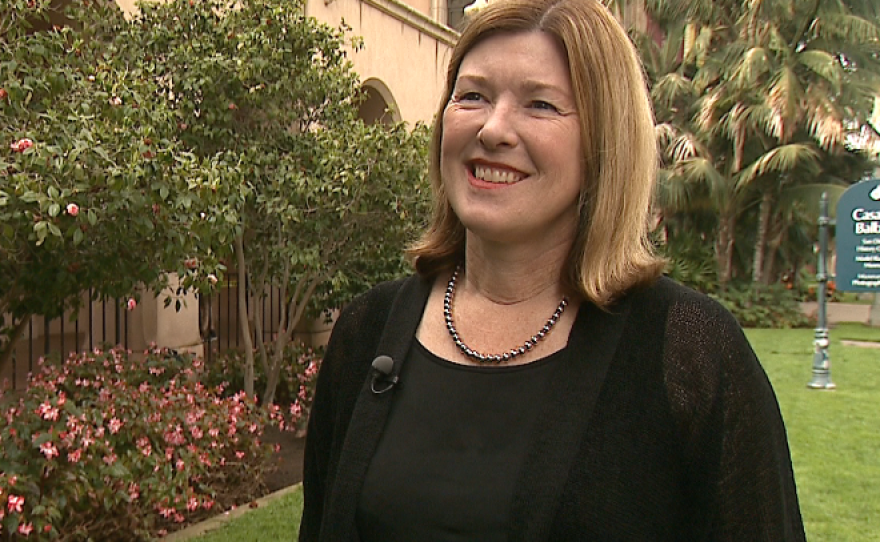The early 20th century was a turning point for women’s rights in America. The right to vote was secured nationwide in 1920. Many states in the West got there sooner. The territory of Wyoming allowed women to vote in 1869. California had women’s suffrage in 1911.
But University of San Diego historian Molly McClain said as much as they wanted political rights, women of the time also wanted some recognition for their place in history and the contributions they had made.
“And so part and parcel of that was to get involved in the world’s fairs. They wanted to have a women’s building of their own,” she said, “where they could have exhibition halls or lecture meetings, where they could talk about other movements that women were interested in.”
San Diego’s place in the world’s fair caravan of the late 19th and early 20th centuries was the 1915 Panama-California Exposition.
That exposition gave rise to the Balboa Park we know today. And it turned out to be a touchstone for San Diego’s women’s movement. Their fight for a role in the exposition involved some of the most notable women in the city’s history, and it echoed similar battles taking place around the country.
Molly McClain has written about the involvement of women in the 1915 exposition. She is also a ninth generation San Diegan who can trace her ancestry to Francisco Lopez, who accompanied Father Junipero Serra to what would become the San Diego mission.

McClain said the movement to guarantee female participation in the world’s fairs began in Chicago, which would be the site of the World Columbian Exposition of 1893. Women in Chicago lobbied Congress, which passed a remarkable piece of legislation.
“A provision that required any world’s fair, receiving federal funding, to include women,” McClain said. “In fact, to specifically include a board of lady managers.”
The influence of women on Balboa Park did not begin in 1915. In fact, back when it was still called City Park, Kate Sessions operated a nursery there, which would be the foundation of her vision for an urban park that was beautifully landscaped and protected from private development.
Nancy Carol Carter is a historian and a member of the Friends of Balboa Park. She said Sessions earned her nickname, Mother of Balboa Park.
“She was such a strong advocate of the park throughout her entire life. She was always someone who was promoting the park, trying to get people to understand why it was important to preserve the park. So she was just the park’s No. 1 cheerleader,” Carter said.

But that didn’t mean the men behind San Diego’s 1915 exposition were inclined to welcome the contributions of women.
San Diego did not receive federal funds for the event, so it wasn't subject to the congressional mandate. In part, the directors of the Panama-California Exposition feared that if women were in involved they would try to ban the sale of alcohol. The women’s movement at the time was closely linked with the temperance movement.
But some of the male resistance also was the result of chauvinism and a patronizing attitude.
McClain writes in her article, “A Room of Their Own,” which appeared in the Journal of San Diego History, that one of the women lobbying the exposition joked that the men imagined a women’s board as “a polite synonym for a squabble court, where the poor dears would meet, discuss, weep and even fight with umbrellas as weapons, then proceed to sulks and hysterics.”
What the men got instead was a threat they could not ignore, she said.
“A group of San Diego women promised the exposition organizers if they didn’t get involved they would take that news to every women’s club in the country,” said McClain, “threatening a female boycott of San Diego’s exposition in Balboa Park, which would be financially very detrimental. And so the men caved!”
On the sale of alcohol, the temperance movement also caved. Beer and wine were sold at the Panama-California event. The expo also had women’s board of directors housed in the California Building, now the Museum of Man.

Along with many social events, the women’s board sponsored live concerts and a public nursery, which allowed more women to attend. The board also brought many events focused on politics and labor. A modern art exhibit, organized by Alice Klauber, would lead to the founding of the San Diego Museum of Art in Balboa Park.
“In 1915, San Diego was not just a cultural backwater,” said McClain, explaining the point the women of the time wanted to get across.
“It had a group of women who were modern, who believed that San Diego could be an incredible progressive community," she said. "And they wanted to showcase their achievements and the achievements of the community to the world. They would do that at the Panama-California Exposition in Balboa Park. “








